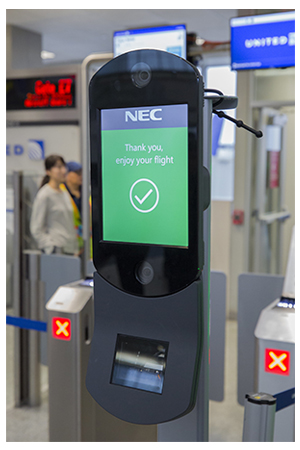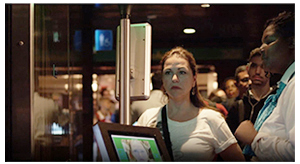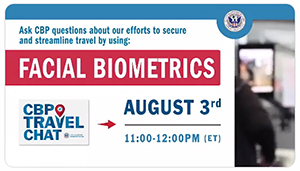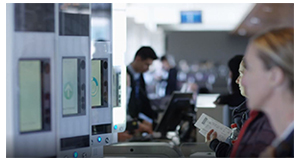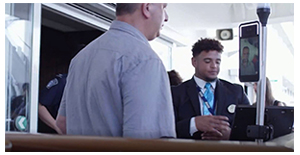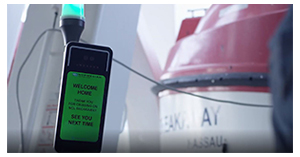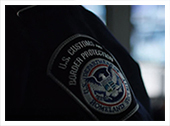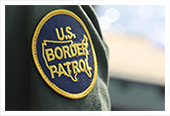In this Update
- Message from the Deputy Assistant Commissioner
- Assessing CBP's Use of Facial Recognition Technology: CBP's Statement for the Record
- CBP Publishes Its Privacy Evaluation Report of the Traveler Verification Service
- CBP Hosts Twitter Chat to Expand Public Awareness of Biometric Technology
- Enforcement News from Across CBP
Message from the Deputy Assistant Commissioner
CBP Access is an electronic newspage developed by the Office of Congressional Affairs for Members of Congress and staff. If you are interested in subscribing to the CBP Access email distribution list, please send an email to OCAInquiry@cbp.dhs.gov.
DHS – and by extension, CBP – is statutorily mandated to develop and implement an integrated, automated entry and exit data system to match records, including biographic data and biometrics, of noncitizens entering and departing the United States. This CBP Access update highlights CBP’s latest biometric technology enhancements and processes that increase border security, protect the privacy of travelers, and integrate with current travel infrastructure.
–Stephanie Talton, Deputy Assistant Commissioner, Office of Congressional Affairs
Assessing CBP's Use of Facial Recognition Technology: CBP's Statement for the Record
CBP submitted a Statement for the Record for a July 27 hearing on, “Assessing CBP’s Use of Facial Recognition Technology,” before the House Committee on Homeland Security, Subcommittee on Border Security, Facilitation and Operations. The statement outlines CBP’s statutory mandate, brief history of technology testing and pilots, as well as the advancement and implementation of biometric facial comparison technology.
In a section describing its technology CBP states, “CBP’s biometric facial comparison technology standardizes, automates, and enhances manual processes by making them more efficient, accurate, and secure. The Traveler Verification Service is the cloud-based, facial biometric matching service that is the foundation for CBP’s biometric verification processes at U.S. ports of entry.”
The use of biometrics stems from the 9/11 Commission Report which instructed CBP to biometrically confirm visitors in and out of the United States. As technologies have evolved, facial comparison has become the most efficient solution:
- During boarding or arrival, a traveler's photo is taken where they would normally present a passport for inspection.
- The photo is compared against an existing passport or visa photo.
- A CBP officer interviews the traveler to validate results, establishes the purpose and intent of travel, and determines admissibility.
- All traveler photos of U.S. citizens are deleted, and no photos are ever shared with industry partners.
Today, millions of travelers have already experienced the benefits of Biometric Facial Comparison technology. CBP developed TVS to be scalable and applicable to all modes of travel. CBP has successfully implemented facial biometrics into the entry/arrivals processes at all international airports, 26 seaports, and all pedestrian lanes at both the Southwest border and the Northern border land POEs.
CBP is committed to traveler privacy and uses biometric facial comparison technology only at specific times and locations where travelers are already legally required to present proof of identity. CBP and its approved travel partners notify travelers through message boards, electronic signs, and sometimes audio announcements to explain the process and to notify eligible travelers of the “opt out” rights.
CBP has an ongoing public awareness campaign to increase traveler knowledge of the facial comparison program. For more information, please review CBP's Statement for the Record and visit biometrics.cbp.gov.
CBP Publishes Its Privacy Evaluation Report of the Traveler Verification Service
As part of its continuing effort to promote organizational accountability and transparency, CBP released a report of the Traveler Verification Service (TVS) – CBP’s biometric facial comparison technology – as part of its Biometric Entry-Exit (BE-E) Program. CBP’s Privacy and Diversity Office conducted a CBP Privacy Evaluation of the BE-E Program’s use of TVS in accordance with the conditions outlined in the 2018 TVS Privacy Impact Statement, to determine whether the BE-E Program collects, maintains, uses, and shares information using the TVS in compliance with the privacy mitigations described in its PIA, the DHS Privacy Policy Guidance Memorandum on the Fair Information Practice Principles, and the CBP Directive for Privacy Policy, Compliance, and Implementation.
The report found that CBP is utilizing TVS in support of the BE-E Program in a manner that is compliant with requirements in current privacy compliance documentation, DHS/CBP policy, and U.S. law.
The report defines the requirements and reviews actions, findings, and any recommendations for system use, including issues regarding transparency, individual participation, purpose specification, data minimization, use limitation, data quality and integrity, security, accountability, and auditing.
For additional information on CBP’s biometric facial comparison technology, please visit biometrics.cbp.gov.
CBP Hosts Twitter Chat to Expand Public Awareness of Biometric Technology
On August 3, CBP hosted a live Twitter chat answering questions on CBP’s use of biometric facial comparison technology and discussing how it allows for a more seamless, secure, and safer travel experience. Below is a sample of the questions and answers:
Q1: With facial biometric/paperless entry, will form 6059B still need to be typed in at the kiosk?
A1: For our Trusted Traveler Programs we are working towards converting all of our kiosks to touchless and paperless forms. For more information visit: ttp.dhs.gov
Q2: Do you have any experiences of challenges faced especially dark-skinned women in regards to facial recognition? Their passports are defined more than others?
A2: CBP uses a high-performing algorithm that is continually evaluated, and we also partnered with @NIST as part of this process. We have seen no measurable difference in performance based on demographics.
Q3: How long is my image stored? Do I have to update it like a driver’s license photo every couple of years?
A3: CBP compares photographs already on file (Passport, Visa, Previous entries). CBP discards U.S. citizen photos within 12 hours. Updating your photos is not required. CBP enrolls the majority of non-U.S. citizen travelers in the DHS Biometric Identity Management System as a biometric confirmation of entry or departure and retains the photos for up to 75 years.
Q4: I have the same name as a bad person. Got redress#. Still being pulled out of line and released. Will this help? Didn’t at Canada border 1mo ago.
A4: Yes, it will help confirm your identity at locations where facial biometrics is available. For a full list of locations where biometric entry/exit is deployed, visit biometrics.cbp.gov.
Q5: Wondering if returning home from abroad without a passport of U.S. what supposed to do, how to advise CBP officer in advance?
A5: If your passport is lost, visit travel.state.gov.
Q6: Are the biometrics that are collected and retained used for purposes other than ensuring an efficient travel experience? How do you maintain the privacy of the individuals whose biometrics are collected? Is there interagency sharing of this data for purposes of national security?
A6: CBP’s facial biometric program is used solely to verify identity at a time and place where an individual would normally expect to present themselves for identity verification. CBP is committed to its privacy obligations and has taken steps to safeguard the privacy of all travelers. CBP provides privacy notice to travelers through signage, tear sheets, the CBP website and other channels. DHS has issued over 10 Privacy Impact Assessments on the Entry/Exit program describing the collection, use, storage, and maintenance of data collected through biometric facial comparison technology. For more information visit biometrics.cbp.gov/privacy.
Q7: CBP normalizes surveillance technologies, like facial biometric apps, by suggesting it is necessary for streamlined and secure travel. And who will have access to the data? For how long with the data be retained?
A7: CBP’s collection for facial biometrics for entry and exit processing is not surveillance. CBP is merely automating the manual ID check currently used at ports today, which will further secure and streamline travel while protecting the privacy of all travelers.
Q8: What companies are you working with to provide this capability on a large scale?
A8: CBP’s Office of Information Technology developed the Traveler Verification Service, the backbone for CBP’s facial biometric program, for implementation and deployment to all ports of entry.
For additional information, and to participate other CBP travel-related discussions on Twitter, follow @CBP or search for the #CBPTravelChat hashtag.
Enforcement News from Across CBP
U.S. Citizen Wanted for Capital Murder Repatriated to the United States
El Paso, TX — On September 21, CBP officers coordinated with local, state, federal and international agencies to repatriate a 20-year-old male, U.S. citizen, wanted for capital murder. The individual, who had been captured in Ciudad Juarez, Chihuahua, by Mexico State Police officials, was escorted to the international boundary line secondary inspection where biometric verification confirmed his identity along with the active warrant for capital murder multiple persons. The individual was arrested by CBP officers and turned over to the United States Marshals Service.
Del Rio Sector Border Patrol Agents Arrest Convicted Murderer
Del Rio, TX — On September 13, U.S. Border Patrol agents assigned to the Uvalde Station in the Del Rio Sector arrested a man convicted of murder, shortly after he illegally entered the United States. After apprehending a group of undocumented migrants, Agents transported the group to the Eagle Pass Processing Facility. Record checks revealed that one subject, Reggie Alfredo Larios-Lopez, 43, of Nicaragua, was convicted of multiple felonies, including murder, in 1996 in Miami and sentenced to four years of confinement. Larios-Lopez has been twice deported, most recently in June of this year. As a convicted felon, he faces a charge of 8 USC § 1326 – Re-entry after Deportation, which carries a maximum sentence of up to 20 years in prison.
AMO Agents Deploy New Hoist Rescue Aircraft Capability
Aguadilla, PR — In early August, the CBP Caribbean Air and Marine Branch (CAMB) conducted its first UH-60 hoist rescue of a migrant trapped on a rocky cliff and immediately made this new capability available to assist with Hurricane Fiona rescue operations. The CAMB currently has two hoist capable UH-60 aircraft that have been made available to federal and state response authorities to respond and recover after Hurricane Fiona. CBP Air and Marine agents continue to see an increase in maritime migration events where people end up in the water. Because of these situations, AMO agents are testing and evaluating several new tools and pieces of equipment to help save lives.
Office of Congressional Affairs | September 2022



